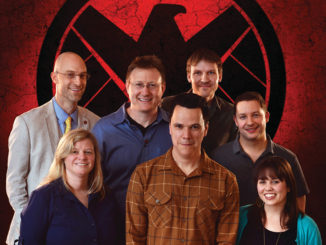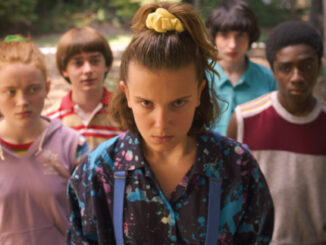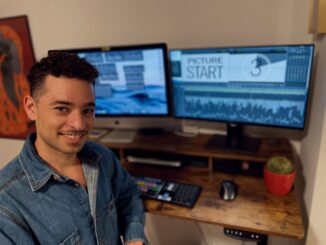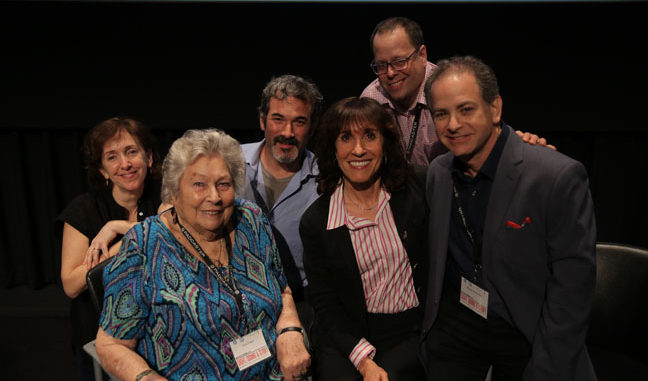
by Dan Ochiva
If you’re in New York and involved in post, the daylong Sight, Sound & Story is a not-to-miss annual gathering that you don’t want to mix. Now in its fourth year, it is organized and run ably by Josh Apter and the Manhattan Editors Workshop staff.
One lovely Saturday this summer, over 300 editors, filmmakers, and post-production professionals opted to pack the NYIT Auditorium on Broadway for a full day of panels focused on the art of editing documentary films, episodic TV and visual effects.
To top things off, the afternoon ended with an in-depth discussion lead by Bobbie O’Steen with legendary Oscar-winning editor Anne V. Coates, ACE. The American Cinema Editors sponsored the end-of-day networking party, which stretched on for two hours and gave many attendees a chance to discuss the day’s panels and interview.
Visual Effects: Behind the Green Screen and the Integral Role of the VFX Team
Moderator: Ross Shain, Chief Marketing Officer at Boris FX and Imagineer Systems. Speakers: Sean Devereaux (Hardcore Henry, The Magnificent Seven), Ed Mendez (The Leftovers, Sin City, X-Men 2), and Alex Lemke (The Hobbit: The Battle of the Five Armies, Into the Woods)
Improvements in GPUs and software over the past decade have dramatically changed the potential of today’s film, television and now Internet productions, delivering full of the latest results with top-notch effects. Visual effects artists and editors directly benefit from software and hardware. Render times on complex frames, for example, have dropped to fractions of what it took six years ago using much more expensive gear.
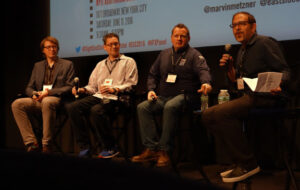
Today, an average movie might have 200 effects shots. A VFX supervisor — who has to be familiar with both standard editing as well as effects creation – has become a necessary part of the team, sitting over this crucial domain. Meanwhile, visual solutions that harken back to classic Hollywood dramas now find their way onto today’s faster paced production schedules. Ed Mendez screened footage from HBO’s The Leftovers.
Quarter-sized houses were burned down for the ending of season one, said Mendez. “While CGI has replaced most of [the historical] approaches, physical models are still preferred when the subject has to interact with fire, explosions or water,” he said. “Those three items have motion that’s so complex that it’s often quickest to turn to the real world instead.”
While directors and producers appreciate the new power just as well, there’s no secret that most shows would prefer to spend less on effects while cutting costs and post. That’s where a visual effects coordinator can help by knowing about the crews and technology on tap at the moment, knowing how long it will take for any VFX to be created then edited in.
VFX supervisors have power that almost seems clairvoyant: They can tell you how long post-production will take at just about any point along the way. Most film and TV productions budget their time carefully. But you always have to look out for a sequence coming in from left field.
According to Sean Devereaux, a top VFX supervisor must evaluate the director’s vision, supervise his VFX team as well as the other editors on the film and, of course, bring the job in “on time and under budget.” Production delays have to be minimized as soon as they turn up, of course. Ideally, problems can be handled on set, but sometimes the VFX crew becomes involved when complex situations turn up. To set that up, after a screening of the café scene in The Equalizer, Devereaux followed it with behind-the-scenes shots of a blue screen set up that had architectural elements of the actual café.
“We had a location that was working fine, where much of the café sequences were shot,” he said. Typical long production days are what tripped the need for VFX. Chloe Grace Moretz plays the young prostitute in the scene. That was fine until someone realized that she was still 17. She was not allowed to work past midnight. That’s not a rule SAG is flexible with.”
As the VFX supervisor, he was able to move back and forth between the set and the effects artists to work things out quickly. The solution was simple: re-create part of the café using enough carpentry and blue screen to give the director options.
“It’s that I hear from the director as soon as possible on whether or not a shot will work in the film as he envisions,” said Devereaux. “I meet with the director on any pre-planning sessions, since it’s very important for me to get a sense of where the film is headed. When I move to post-production, I have answers to ‘What does he want to do here?’ for my artists and editors.”
Production today is faster. Everything going digital is one factor. Chopping up post-production to spread the work around is standard with VFX. So how fast are things getting? On fast turnaround films, editor’s cuts might have to be turned in at around two weeks, while the director might get 10.
In the analog days, studios had their own special effects departments. That’s not what happens today, though. If a director doesn’t like how certain effects turned out and wants them redone, it’s the visual effects house that picks up the tab.
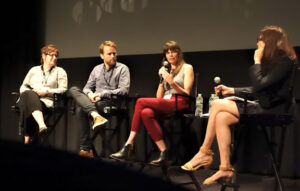
Photo by Dan Ochiva
As vendors, effects houses are not part of a production’s regular payroll either. You might be expecting that check by Monday, said Devereaux, “But you might not get it for six weeks,” which can be a disaster for a small business. Studios have also pitted visual effects houses against each other, with some purportedly taking a loss bid so that they keep their relation with a studio. With ever-tighter margins that pushed many VFX houses to Canada or overseas, panelists cited efforts to unionize as one possible, though admittedly long-term, move.
Editors might have their work undone by colorists working on the DI, said Alex Lemke. One sign of the trend? Productions are asking for full rendering of the elements of composite shots, leaving it to DI to complete.
Unlike many of the panelists, Lemke started out in the German film industry, handling film and learning how to make old-school effects using optical printers. “I enjoyed the work,” said he. “But budgets for film and TV are still pretty small for anyone working in Germany. I saw the effects-heavy films coming out of the US, so this is where I had to go.”
With some 200 visual effects in movies today, he’s found plenty of work.
Finding the Thread: Deconstructing Documentary Films
Unlike California or other locales where feature films dominate, New York has always had a tradition of a vibrant independent documentary community. You saw that in the top-level projects brought up by this panel, as well as the sophisticated level of discussion itself.
Remembering an Editor
Before the panel started its discussion, Erin Casper, editor on American Promise and The Last Season described and updated attendees about the Karen Schmeer Film Editing Fellowship, which helps young editors at the beginning of their careers via mentoring and other benefits. Casper herself won the first year of the fellowship in 2011.
Karen Schmeer, ACE, was a talented editor on films from Errol Morris to Sidney Pollack who also worked to help a variety of people she knew, whether helping young editors who needed a perceptive critique to baking a pie for friend in need of cheering up. She was tragically struck and killed by a hit-and-run driver in January 2010, three weeks before her 40th birthday. It’s heartening to find someone’s strength and kindness regularly remembered when editors gather.
Remembering a Crime
While a more traditional documentary might state the film’s premise somewhere in the front of the edit, Gabriel Rhodes (The Tillman Story, Newtown) described his approach to editing The Witness — A Documentary About Kitty Genovese. The tabloids’ handling of the initial event caught fire, becoming a wary tale of modern city apathy: Neighbors in a 1960s New York neighborhood supposedly watched and did nothing upon hearing the young woman’s screams.
After 40 years, the murdered woman’s brother finds out that the story might not be true and thus began his own 10-year research to find the truth. The Witness works by first sketching out the established narrative that most accept, and then bit-by-bit subverting it.
Though the nominal director is James Solomon, Kitty’s youngest brother Bill Genovese becomes the on-screen investigator, one that the audience starts following raptly. The deep emotional context that Genovese could bring to the edit room brought insights to material Rhodes only knew from a distance. “He knew the story and complexities of it and could talk about Kitty and the family for hours,” Rhodes said.
Too much personal detail can bog an editor down, and that very intimacy can backfire. That’s the case here, with resulting tension in the edit suite between Rhodes and Genovese. “Key people can get too attached to their material,” said Rhodes, who remarked that one of Genovese’s brothers died during post. “He was understandably emotional. I had to get past that in some way. You have become more objective then, looking at things with more of a cold heart, so that decisions can get made.
Rhodes is also no fan of the traditional approach of watching hours upon hours of the shot footage as a first step in his editing process. “I love transcripts,” he said. “I just get bored watching footage. I would much rather first read the transcript.”
After getting a handle on what the footage contained, Rhodes next centers on discussions with the director or anyone intimately involved in the film or even just the history it tells. “I’m interpreting their footage on behalf of them,” said Rhodes. “
Multiple Editors Take on American Promise
Casper showed a scene from the doc American Promise, an epic 14-year personal documentary of two black parents who documented their two boys in hope and despair as they moved through private and public schools in New York. Unusually, the parents acted as directors and shot the sequences over the years.
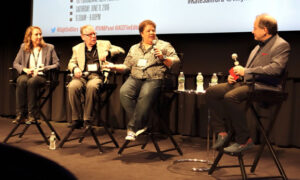
Photo by Dan Ochiva
Three editors — Casper, Mary Manhardt and Andrew Siwoff — started working on some 500 hours of footage. A number of other editors were credited with helping along the way over the years. Keeping things simple as they began, Casper noted how complex their job felt when they began. What is the best strategy for splitting up that much material while keeping track of any potential story lines? How can you be sure that one of the editors hasn’t passed over a topic that you wanted to explore?
You don’t cut much at first. Just what’s necessary. “After four-and-a-half months, we arrived at a 32-hour assembly,” said Casper. Although they still had a huge amount to do, Casper said that she prefers screening all the material but only with a transcript. “I want to have my own first response to the material,” she added.
Her next move was straightforward too; Casper placed all of the initially culled material onto the NLE’s timeline, then elevated selects onto their own lines. One final approach reflected something reality TV figured out a while ago when dealing with lots of footage with no obvious storylines. “We finally started cutting fast when we defined different characters each with their own personalities,” said Casper.
TV is the New Black: Television’s Cinematic Revolution
Moderator: Michael Berenbaum, ACE (The Americans, Sex and the City)
Speakers: Kelley Dixon, ACE (Breaking Bad, Better Call Saul, The Walking Dead), Kate Sanford, ACE (Vinyl, Boardwalk Empire, The Wire), Leo Trombetta, ACE (Narcos, Mad Men, Temple Grandin)
With some of the most experienced editors in the business on his panel, Michael Berenbaum noted that they have worked on the most honored series in TV history. But he asked them to start small, with just a little info about how they got in the business. That’s a subject that the young filmmakers in the audience always ask, so Berenbaum did it for them.
Kate Sanford said that even though she grew up in LA and had a father in the film business, she didn’t want to be on set or stuck in business meetings with producers. “I wanted to be in the dark corner were they made things,” said Sanford.
When she started out as a PA, she knew exactly where the editing room was. That’s where she ended up when she had any spare time, asking questions, getting shown solutions. “I knew that’s where everything came together,” she said. “It was always the most interesting place to be on a production.”
Leo Trombetta relied on a bit of serendipity, starting with a job at a New York’s Museum of Broadcasting after college. Woody Allen’s sister headed the publicity department. Only when he got fired from the museum, however, did he finally ask her for places to try for work. The basic advice was that Trombetta needed to visit two facilities — Sound One and Trans Audio, two houses that handled almost the entire feature and commercial audio work in New York. “I haunted those two places until someone doing a documentary took pity on me and offered me a job,” said Trombetta.
Kelley Dixon moved to LA, but initially wanted to write ad copy to pay the bills. “I tried and tried, but that didn’t work out,” said Dixon. She also tried many different production houses with similar disappointing results. It was that old “friend of a friend” connection that finally worked. “The guy that ran the MGM/UA mailroom had a crush on my girlfriend,” said Dixon. She got the interview she needed, and began working in that mailroom.

Trombetta discussed the decision-making that the showrunner and producers on Fox’s Wayward Pines went through when the season one finale felt too inconclusive. When he got the call from a producer one Sunday, they discussed what they might do. The set had been struck already and the actors, including a principal Matt Dillon, went their separate ways.
Showing the original version and the re-cut version, Trombetta described how quickly he had to work, especially since he had no new footage and needed to edit Dillon’s character out. A further problem was that while the producer wanted to build out some other scenes, no background plates had been shot, since that wasn’t anticipated. Trombetta solved the problem by replacing Dillon’s character with another as well as extensively re-working the background plates he had on hand.
Sanford spoke about her previous work on The Wire. Creator David Simon trusted his team; he’d pushed them to be as creative as they could. “Nobody was around the first whole week and I wondered, ‘How long is this going to last?’ Well, it went on until the end of the run,” she said.“But there’s a lot of product out there” with the result that everything is maxed out. “The TV production landscape is so big today, you just can’t cut through it,” she added.
Dixon recalled how Breaking Bad creator Vince Gilligan encouraged her to take creative chances and to not “rob him of any riches” in the edit room.
Inside the Cutting Room with Bobbie O’Steen: A Conversation with Oscar-Winning Editor Anne V. Coates, ACE
Saved up for the end of the day, the hall was fired up with Bobbie O’Steen’s one-on-one with Anne Coates. While she’s over 90 years old, Coates didn’t hesitate to fly in from London as “I wouldn’t miss the event.”
With Lawrence of Arabia, The Elephant Man and Erin Brockovich as just a few of the top titles on her resume, Coates held the audience enthralled with her stories of just what went on.
Still an energetic, enthusiastic and engaged woman, Coates started out working on religious films. Still learning the trade as an assistant to the editor, she showed initiative. Breaking into the editing world was a little simpler then, as “one editor went home early to work in his garden. That gave me my first chance to finish things.”
As she had three brothers, “I was used to working with guys,” said Coates. “I expected to be treated well and to make the same amount of money as the men.”
The stories were plentiful about her challenges — she faced 13 miles of dailies with David Lean’s Lawrence of Arabia — and a fun, putting-the-puzzle-together experience with Beckett, during which storied actors Richard Burton and Peter O’Toole were “drunk out of their minds” throughout the shoot. “I had only bits and pieces of the takes that I could use,” said Coates. “But with actors this good, it really didn’t matter.”
O’Steen wrote this reporter afterward; her thoughts about Coates give a good sense of this editor’s importance. Both for her innovations in the editing room as well as her openness to helping young editors get their start, Coates sets a standard any editor might back.
Here’s O’Steen’s letter:
“I think what is interesting is that she is so witty, charming and lovely. It almost throws you off from the fact that she has so much determination and grit.
“When she said she considers herself an editor, rather than a woman editor, I think it served her well. I’m thinking especially of those days — the ‘50s and ‘60s in England — because she had to have this single-minded focus that made her plow past the hurdles, seize whatever opportunities presented themselves to her and run with them.
“ I love the story about her first film — The Pickwick Papers — regarding the “misogynistic” director, who didn’t like a certain actor and so didn’t cover him in a scene. Anne said to him that she needed close-ups for the edit. To which the director responded, “Then shoot ’em yourself.” So she did! That said it all. First film!
“There is also a part of her that embraces her femininity. She talks about nurturing her directors, being both sensitive to and appreciative of their interaction. It’s revealing that her favorite quote is from director Carol Reed, who said that of all the editors he worked with, she is the one with the most heart.
“Also, it was important for me to show her flexibility and range in the choice of clips at our event, how easily she can slip into broad improv comedy (What About Bob?) or very poignant, subtle emotion (The Elephant Man).
“She is truly an inspiration. And also her memory, at 90, is perfect. She never even struggles to remember names, which we all do. I prep a lot and have long conversations beforehand with my honorees, so most of the time I have an idea of what they’re going to say, but I threw her some unexpected questions, like what was the alternative ending for What About Bob? She didn’t even take a beat to remember.
“Maybe all that puzzle-solving that editors do keeps their minds flexible and spry.” If so, she is certainly a testament to that.”
To see the video of O’Steen’s interview with Coates, go to this location on Manhattan Edit Workshop’s Facebook page: https://www.facebook.com/mewshop/videos_by


